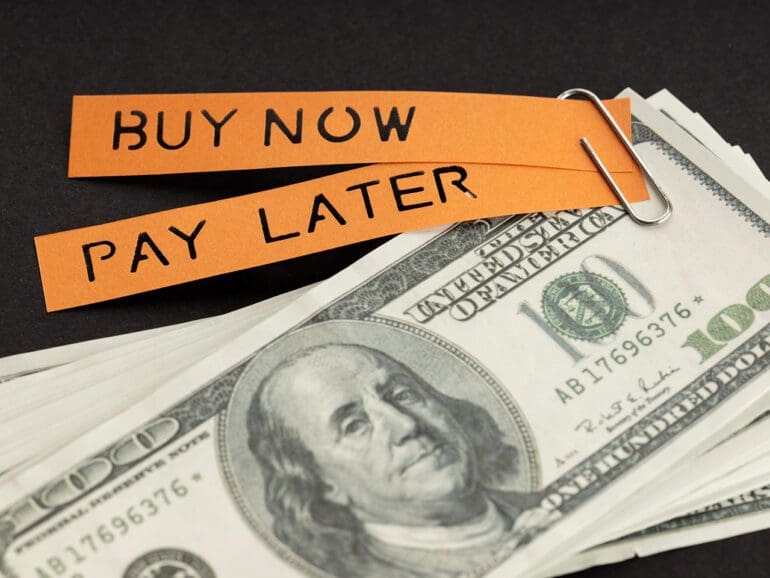As scrutiny of Buy Now Pay Later increases, so too do satisfaction scores among customers using the short-term financing mechanism structured like an installment loan.
While the United States federal government’s Consumer Finance Protection Bureau has been monitoring BNPL for years now — more recently calling into question some BNPL firms’ sales practises and use of personal data — J.D. Power‘s annual report on customer satisfaction for it has found the payment option continues to grow in popularity.
Overall, contentment among all 4,135 users the firm specializing the examination of consumer behavior surveyed for its 2024 U.S. Buy Now Pay Later Satisfaction Study — be they financially healthy, vulnerable, stressed or overextended — is up 16 points on their 1,000-point scale to 634 from a year ago.
J.D. Power considers the rise significant. Financially healthy customers are the most-satisfied of all, financially vulnerable the least-satisfied. Today, 28 per cent of customers are using BNPL as a payment option, says Miles Tullo, the managing director of banking and payments at J.D. Power.

“There’s a lot of room there for continued growth as people (grow) comfortable with it,” Tullo said in an interview.
“The No. 1 reason people state, when they use Buy Now Pay Later, is they want to defer their payments to later, but … No. 2 is repayment terms are reasonable. That’s like No. 11 or 12 or somewhere in that range for credit cards.
“Consumers look at a credit card, and they can defer their payments to later on a credit card as well, but the terms they don’t find reasonable most of the time. As we know, credit card debt is large, and there are a lot of people that have it, so to the extent that a Buy Now Pay Later solution works for a consumer in terms of the repayment schedule, they’re going to be potentially more likely to use that going forward as they get more comfortable with it than they would be revolving on a credit card purchase.”
Segment’s growing popularity expected
Tullo said there is a fear that BNPL attracts overextended customers “who are using it because they have no other choice and it’s an easy way to find more money,” but that BNPL firms have been “very careful how they manage that if they want this to be a viable product long term.”
“Understandably, that’s where the concern is,” Tullo said. “Within other areas, if people are using it smartly, it certainly is pretty good.”
For Kevin King, the vice-president of credit risk for LexisNexis Risk Solutions, the growing populatity of BNPL is the U.S. is expected given how much it’s been accepted in parts of the world that have been using it longer.
“When we’ve looked over at consumer sentiment in Europe and Australia, which (are) in many ways (some) of the birthplaces of Buy Now Pay Later, it is quite high,” King said in an interview.

“Seeing that more consumers are getting exposed to this and its popularity (in the U.S.) is going up makes sense.”
Another key finding in the second-annual study suggests newer service providers are seeing the biggest increases in BNPL satisfaction scores, arguably an indicator that there is room to grow in the payment segment and that customers are comfortable using it.
King says those new players have taken the temperature of BNPL and are entering the market prepared to overcome or avoid obstacles.
“They’ve had the benefit of watching what consumers do and don’t like about these services for several years before hopping into the water, so that helps them come out of the gates with something that might avoid pitfalls that other providers had struggled with, he said.
Tullo says while large, established brands benefit from “their incumbency and their brand recognition” and despite rating highest in the study for overall satisfaction, “year over year, those top brands are relatively flat.”
Regulation unlikely to derail popularity
“Satisfaction is about the same as it was last year, it hasn’t increased, hans’t decreased, whereas the the brands that are less familiar have increased significantly,” Tullo said.
“The takeaway there is that as consumers get more and more comfortable with these brands — they use them, they try it, it works well — naturally, they will start to feel better, and we can see that.
“We can see the perception of these brands is increasing. They have a better reputation, the sense of security in using these brands and so on is all increasing, and potentially and eventually, will likely catch up to the bigger names unless there starts to become some more differentiation between the product sets.”
Read more about BNPL
- Walmart’s One now offering BNPL in-store
- BNPL appeals to broad spectrum of users: report
- Embedded lending can solve BNPL’s in-store checkout problem
Still, the prospect of regulation is on the horizon given the CFPB’s ongoing audit of the BNPL landscape in the U.S. That, however, won’t derail BNPL’s popularity, King says, adding that standardization for it could lead to more people being able to access credit.
“(People) might initially hear that and go, ‘This behavior getting reported to the credit bureaus, is that really good? When I hear about things getting reported, I naturally associate that with scores going down,’ but a lot of this is saying, ‘We’re going to tell young consumers — consumers with limited access to traditional forms of credit — that this is a really viable way to secure affordable credit,’ to help get financial stability, where you would like them to get recognized for their responsible behaviors and managing those responsibilities,” King said.
“Having that ultimately boost the credit scores that tend to inform the really big purchases that Buy Now Pay Later can’t really help with right now.”
He also said it’s inevitable and “only fair” that BNPL providers be regulated just like any organization giving loans.
“I think trying to create a level playing field between all organizations that are issuing consumers credit, and making sure consumers get probably recognized for their managing of those responsibilities, those feel like really good aims,” he said.


